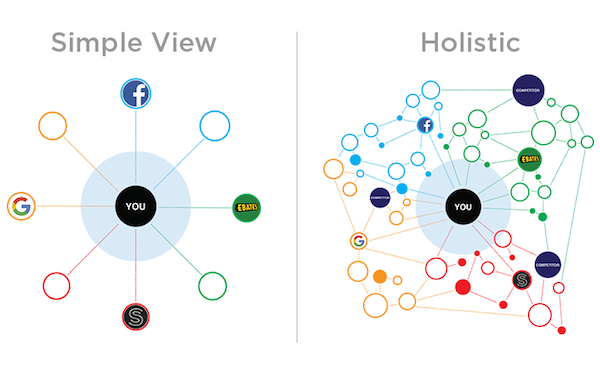What should be the role of marketing in the semantic web?

Cool stuff, but it sounds very IT-ish, not very marketing-esque.
But consider this circular, three-step riddle:
- if the semantic web is successful, it will unleash an enormous wave of information exchange between organizations and individuals, empowering a new level of findability and knowledge sharing;
- for the semantic web to be successful, organizations must assign responsibility for their participation in it to someone who will lead and manage it — otherwise the semantic web devolves into semantic soup;
- for someone to take responsibility, there’s going to have to be incentive; in the commercial world, incentive translates most directly into generating more business — which is inherently a function of some form of findability and compelling knowledge sharing.
Hint: for generating new business in the non-semantic web, findability = ads, PR, word of mouth, SEO, etc.; knowledge sharing = feature sheets, pricing, case studies, white papers, etc. Whose domain is that?
The answer to the riddle: marketing. If the semantic web could be harnessed to generate more business — essentially be a new channel to the market — then the marketing department can and should step up to lead its adoption in the enterprise. Arguably, this will be necessary for the semantic web to reach its full potential.
But marketing in the semantic web clearly won’t be like marketing in the visual web. Advertising and branding won’t exist in the form we know today. Sure, marketing will continue on its current trajectory in the visual web — accelerated by semantic technology in certain areas such as search engine marketing. But what will it mean to market one’s organization at the semantic layer?
Here are my preliminary ideas of 7 missions for semantic marketing, marketing in the semantic web:
(1) Marketing becomes the champion of the underlying data — good, accurate, detailed content and the processes by which to keep it up to date. This isn’t just old-school “marketing” data, i.e., the stuff of brochures and the visual corporate web site, but rich, detailed information that historically been trapped much deeper in the organization — information that can create value for the firm by its wide dissemination (or, as we’ll discuss shortly, that can create value through bargaining with others).
Part of this job is uncovering existing data. But perhaps the more important part is advocating for new data feeds, re-engineering the organization to generate semantic web content as a competitive advantage.
(2) Categorization of all that data, framing with the right metadata, supporting the relevant microformats, and deciding how to best componentize it at different scales — atoms, molecules, living cells — to maximize findability and mashability. This will include proactive work with partners, customers, and industry groups to coalesce standards for domain-specific metadata.
This constitutes a new kind of market positioning and placement via the semantic web, semantic branding if you will. Accordingly, you can almost imagine a key role of chief ontologist in the marketing department. Okay, maybe director of semantic branding sounds better. (A more literal meaning to the old hype line, “Our company is redefining the market.”)
(3) Distribution and promotion of your data through formal and informal networks of all kinds, analogous to what search engine optimization (SEO) is today — semantic web optimization (SWO)? — to extend your reach as far as possible. This will be SEO+ and then some. Marketing will want to sponsor or create new semantic networks (and subnetworks within existing networks) that cater to specific audiences, drawing from the same techniques that are emerging in social media marketing. This also contributes to semantic branding — “where” your company is in semantic cyberspace.
Perhaps this will lead to a new type of semantic advertising? People paying to have their semantic data distributed through certain networks, tagged with certain metadata under the authority of the network owner. I believe there are vast entrepreneurial opportunities for vertical market networks here.
(4) Structuring incentives to convert semantic web interactions into real business objectives. This may be the greatest business model challenge in semantic web marketing, since there’s an inherent tension between openness and incentives. Information asymmetry shouldn’t go away, but it should be managed more consciously — achieving the right balance becomes part of a firm’s marketing strategy. (Vaguely comparable to the dynamics of open source software businesses?)
If your contributions to the semantic web have value to your prospects, customers, partners, vendors, etc., then you can bargain to receive things you want in return: leads, promotion, feedback, reciprocal access to their extended semantic web data, etc. Access control here doesn’t have to be all or nothing either. Data can be more or less detailed, can be more summarized or more atomic, can have varying levels of metadata, can be delayed or more real-time, and so on. These choices can be made on a very context-specific basis: which data for which audiences under which circumstances.
(5) Tracking and attributing distributed data in the semantic web, measuring the impact of the different content elements that contribute to customer and partner relationships. This is probably the toughest technical challenge, as we go from complex multi-touch marketing to ultra-complex micro-touch marketing. The very nature of the semantic web encourages wide reusability of data, largely culled by software behind the scenes — or as I like to call it, mashing and caching — which runs counter to the architecture of many of the current web analytics systems. (Web 3.0 analytics make the troubles of Web 2.0 analytics look like a cakewalk.)
The good news, however, is that we should be able to harness the semantic web to help solve this problem. Metadata structures that identify a “chain of contribution” with ping-back type mechanisms. Or something akin to friend-of-a-friend (FOAF) for businesses and their more atomic components. Thinking of incentives, per (4) above, those who cooperate with your tracking system can be rewarded with greater access. Streams of freshly generated data — engineered with the semantic web in mind — also become more valuable because they stimulate more frequent requests, which are the touchpoints easiest to measure. Entrepreneurial ingenuity will prevail.
(6) Leveraging other people’s data in your own value-add mash-ups. For customer-facing applications, this is where your organization’s semantic web inputs and outputs surface into the visual web. This next generation of web apps, widgets, and summarized reports and analysis — made feasible by the new level of networked data in the semantic web — will be golden because they directly serve a highly engaged human audience. Enter web advertising and promotion as we know it (with a nice boost from semantic context awareness). Great opportunities for “joint venture” semantic data partnerships — combining your chocolate with someone’s peanut butter (exclusively?) to appeal to a shared audience.
The marketing department can also benefit from mining the semantic web for market research, customer monitoring, competitive intelligence — not to mention a more organized view of one’s own content plumbing and business data pipelines. These will be mash-ups run for internal consumption only, but very helpful in marketing management.
(7) Finally, quality control to watch for bad data, conflicting data, competitive misuse, etc. — essentially brand protection in the semantic web. Someone in the organization needs to play the role of the semantic police, guarding against everything from broken feeds to breaches of confidentiality. There is a case to be made that if marketing is in charge of everything else above, this role should be handled by another group that can provide checks and balances (IT? administration? legal?). But I can think of several good reasons to keep it under marketing’s control with broader oversight only at a higher governance level:
- semantic quality control will be a part of a firm’s online reputation management, which to me is a marketing responsibility;
- the team building and managing a company’s semantic web presence will understand it best — and be better able to respond to issues, judge their severity, appreciate the side effects, etc.;
- while confidentiality is important, there should be strong advocacy to avoid the reigns being too tight — if there’s an overzealousness to label everything as secret (e.g., the legal department), the organization ends up effectively withdrawing itself from the global semantic web;
- as with all things on the Internet, speed in the market is important, and there’s no surer way to slow things down then split them across departments that have competing agendas.
Collectively, these 7 ideas represent a very different kind of marketing.
This is obviously technical marketing, which makes it a great fit for a marketing technology group that lives inside the department, led by a chief marketing technologist who reports to the CMO. (Which, of course, is what this blog advocates.)
Historically, the management of this kind of data would have been an IT task. The big paradigm shift is that marketing must now take responsibility for it because the semantic web will be a conduit by which the firm interfaces to the market. Semantic marketing. Semantic branding. Semantic advertising. These may be novel terms today, but if the semantic web blossoms to its full potential, they will be strategic elements of the marketing mix — well outside the boundaries of the traditional IT department.
As of today, a quick Google for the phrase “semantic marketing” currently returns 396 results. “Semantic advertising” does a bit better with 665 results, but some of the first pages seem more focused on using semantic data of publishers to plug-in better contextual ads. Different than what I was thinking, but a good idea. “Semantic branding”, a mere 17 results. Any bets for how many results these terms will have by March 2009? March 2010?



Read your comment on RWW and had to come over and see your blog post. Wow. So incredibly spot on. Going to take some time to digest, but hey, consider yourself bookmarked!
Thanks for putting this together. As Paul mentioned, this is going to take some time to process, but I’m excited about learning a whole new strategy.
@Paul, @Ryan — thanks for the positive feedback! I know what you mean: I still feel like I’ve very early in the process of getting my head around this juxtaposition of semantic web evolution and marketing’s growing reach, both inside and outside the enterprise.
Look forward to exchanging more thoughts on this topic as it unfolds — which it appears to be doing at an accelerating pace.
Interesting thoughts, Scott
I’d be interested in connecting
Some very interesting, forward-looking ideas Scott. No one can be sure where this will end up but it is fascinating and useful to discuss the possibilities. As Buckwheat from the Little Rascals once said (on a runaway go-cart) “I don’t know where we goin’, but we sure on our way”.
This is an interesting insight into the most probable future of marketing and thanks for this expert article. But to me this looks rather like a natural enhancement of database marketing and competitive intelligence by new means instead of the realization of the idea of better analysis of natural language. I am curious, if there will be further future impacts coming up.
Hi Scott!
Thanks for your post!… I’m thinking about these issues under the strategic marketing, branding and sociology perspectives…
Probably the world is moving in that direction… from structure to network, from solid to fluid… And marketing would need to go in that direction too… from function to process…
You can see that in http://www.webjam.com/brand30 (Brand 3.0)…
Cheers!
Scott – very interesting list! Data is definitely the future of marketing and semantics is the key.
Check out ContextIn – http://www.contextin.com Semantic Advertising solutions, providing many of this list.
For a live demo of URL classification, which is useful by itself of many marketing activities – try http://www.urlclassifier.com
I’d be happy to further discuss it with anyone interested
Great article Scott. I’ve been thinking about this a lot and there are countless fantastic applications to semantic web technology – especially for marketers.
I couldn’t help pondering some of the other implications either http://watsonneil.wordpress.com/2010/08/17/sleepwalking-in-a-social-media-nanny-state/
I do think it is absolutely the job of marketing to take ownership of the opportunity, it’s going to be interesting.